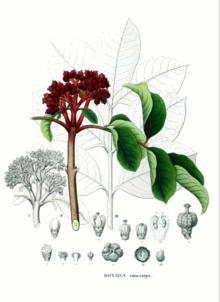Euodia_ruticarpa
Tetradium ruticarpum
Species of tree
Tetradium ruticarpum is a tree that comes from China and Korea. It was previously classified in the genus Euodia as Euodia ruticarpa. The fruit is usually used, denoted sometimes as fructus. It has a strong bitter taste, and is used in traditional Chinese medicine (TCM) and is a recognized herb in Kampo. Both the former genus name and the species name are often misspelled, and the plant usually appears in sources dealing with traditional Chinese medicine as "Evodia(e) rutaecarpa".
This article needs additional citations for verification. (November 2014) |
